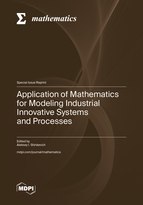Application of Mathematics for Modeling Industrial Innovative Systems and Processes
A special issue of Mathematics (ISSN 2227-7390). This special issue belongs to the section "Engineering Mathematics".
Deadline for manuscript submissions: closed (15 September 2023) | Viewed by 14896
Special Issue Editor
Special Issue Information
Dear Colleagues,
This Special Issue focuses on publications in the field of innovative development processes and mathematical modeling in industry, associated with the formalization of continuous and discrete systems, cyclical development study, global optimum production efficiency achievement in the context of the triple helix of interactions with the study of development traps, similarity and difference assessment applied to the functioning of innovative systems in different countries, regions and types of economic activity based on the use of modern mathematical methods of data processing and visualization, revealing latent patterns, including using computer analysis.
Dr. Aleksey I. Shinkevich
Guest Editor
Manuscript Submission Information
Manuscripts should be submitted online at www.mdpi.com by registering and logging in to this website. Once you are registered, click here to go to the submission form. Manuscripts can be submitted until the deadline. All submissions that pass pre-check are peer-reviewed. Accepted papers will be published continuously in the journal (as soon as accepted) and will be listed together on the special issue website. Research articles, review articles as well as short communications are invited. For planned papers, a title and short abstract (about 100 words) can be sent to the Editorial Office for announcement on this website.
Submitted manuscripts should not have been published previously, nor be under consideration for publication elsewhere (except conference proceedings papers). All manuscripts are thoroughly refereed through a single-blind peer-review process. A guide for authors and other relevant information for submission of manuscripts is available on the Instructions for Authors page. Mathematics is an international peer-reviewed open access semimonthly journal published by MDPI.
Please visit the Instructions for Authors page before submitting a manuscript. The Article Processing Charge (APC) for publication in this open access journal is 2600 CHF (Swiss Francs). Submitted papers should be well formatted and use good English. Authors may use MDPI's English editing service prior to publication or during author revisions.
Keywords
- simulation of cyclic processes
- mathematical risk assessment
- analysis of investment projects
- global optimum
- dynamic supply chain models
- multivariate statistical analysis methods
- big data analytics
- neural networks and genetic algorithms
- mathematical game theory






